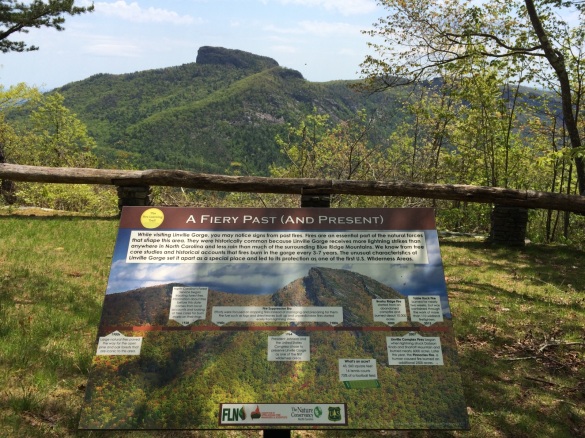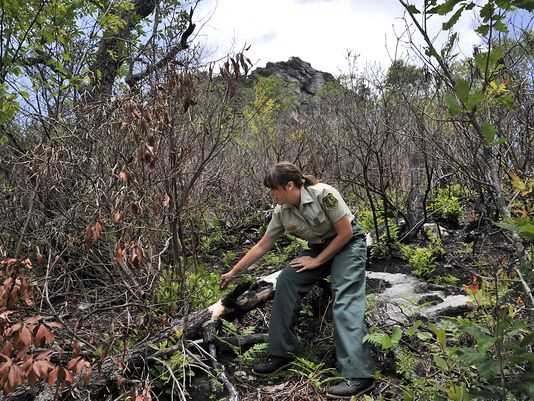Fire Adapted Hudsonia montana, mountain goldenheather, thrives after wildfires on Shortoff Mountain in the Grandfather Ranger District. Cooperation between the US Forest Service, US Fish and Wildlife Service, and The Nature Conservancy helps document their persistence following spring fires.
Three liters of water barely made a dent in my thirst the first hot September day of monitoring rare plants on Shortoff Mountain. So, the second day I brought 4 liters and an umbrella to create my own shade. As we walked in silence, dripping with sweat, back down to the truck, my pants were shredded at both knees from crawling through thorny brush and my umbrella was broken on one side. But I was smiling.
Earlier that day we had spent hours walking near the edge of Shortoff Mountain in Grandfather Ranger District looking for – and finding in abundance – Hudsonia montana. This scrubby little plant, commonly known as mountain golden heather, clings to the rocks almost as close to the edge of a cliff as one can get. It’s a dare devil plant sending USFS botanist, Gary Kaufman, into billy-goat mode as he very carefully picks his way up the cliff side counting plants.
Our goal was simple: use the maps created previous years to visit the areas on Shortoff mountain known to have the golden heather, count the patches of plants using a size-class system and help estimate their current numbers. But why do this now, on a hot September day when summer seems never ending? Because the plants were burned earlier this year by wildfires and biologists charged with protecting this federally listed species need to know the impacts of the fire.
Shortoff mountain has burned on average at least once every decade for hundreds of years. It’s prominent rock outcrops, Table Mountain pine, and bunchgrasses are adapted to the frequent lightning-ignited fires. The little plant we were looking for, Hudsonia, is no different. It thrives in this fire adapted ecosystem and has found its niche, only growing in two counties in North Carolina. In past years there have been dramatic increases in the plants post-fire. It’s kind of like how cutting your grass with a lawn mower helps the grass grow back thicker. Except in this case, Hudsonia grows back after fire and creeps further into and over neighboring rocks and mossy areas.
Once we got back to the truck the second day, botanists from the USFS and US Fish and Wildlife Service planned to come back for a third day to sample a few more areas of plants. What we had seen so far was promising, as expected the Hudsonia as well as other fire adapted plants like little bluestem were growing well. I hope you enjoy this short video showing the Hudsonia and the plants on Shortoff thriving after the spring wildfire.









